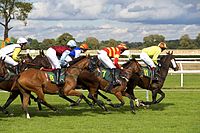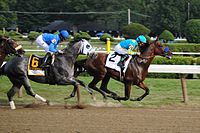Run
As turf is known in horse racing the ground on which the horses run in the race. A basic distinction is made between grass track ( turf ) and sand track (dirt track). The advantage of the sand track is that it can be loosened with suitable equipment even when the ground is frozen, so that races can be run on it. A hard, frozen grass runway is not suitable as a surface because the horses could slide and injure themselves from the bumps.
The snow races on the frozen lake of Sankt Moritz and Arosa in Switzerland are a special case .
In Europe all important races are run on a grass track, dirt track races are mostly held in winter. In Germany there are two "larger" sand tracks, one in Neuss and one in Dortmund . Furthermore, dirt track races are held on so-called “rural” tracks such as in Karlsruhe , Honzrath or Sonsbeck . In America almost all races are run on dirt tracks, grass track races are only held there in exceptional cases.
The condition of a ground depends on many factors, first of all the basic nature of the soil (sandy or loamy soil) and the dryness or moisture of the soil. For racing, it is important what condition the track is in when the race is held. The soil is determined using a measuring device called a penetrometer . The penetrometer measures the depth of impact of a weight in the ground in centimeters, while the weight is dropped from a height of 1.5 meters. The following classifications apply:
- Hard ground, penetrometer value: 0.0-1.4 cm;
- Solid soil, penetrometer value: 1.5-2.9 cm;
- Soil good, penetrometer value: 3.0-4.4 cm (= normal flow);
- Soft soil, penetrometer value: 4.5-5.9 cm;
- Heavy soil, penetrometer value: 6.0–7.4 cm;
- Bottom deep, penetrometer value: 7.5 and more cm.
Hard or firm ground is not favorable for horse races because it puts more strain on the horse's legs (which is also the case with very heavy / deep ground). That is why the ground is watered with irrigation systems when it is extremely dry.
Horses sometimes have special preferences for a certain course. These preferences are often inherited. Therefore, to assess a horse's chances in a race, you need information about the ground. If the ground is likely to be unsuitable for a horse, a race favorite can become an underdog. Horses that prefer a deep run are called " swamp chickens ".
Since the dirt track season in winter 2007/2008, the running condition of the dirt track has been specified in Germany. Mostly, however, this information is limited to the values 'wet' and 'normal'. The winter of 2010/2011 was an exception. Unusually heavy snowfalls caused considerable snow depths in the Rhineland, which is why the soil conditions during the December race days were consistently given as 'firm'.


